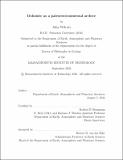Dolomite as a paleoenvironmental archive
Author(s)
Wilcots, Julia
DownloadThesis PDF (59.55Mb)
Advisor
Bergmann, Kristin D.
Terms of use
Metadata
Show full item recordAbstract
Dolomite [CaMg(CO₃)₂] is abundant in the rock record and preserves, in its chemical composition, information about the environment in which it formed. The scarcity of dolomite forming in modern oceans and evidence for dolomite replacing primary calcium carbonate (CaCO₃) in ancient and modern successions, has prompted the idea that most geologic dolomite formed through diagenetic alteration of CaCO₃, a process that weakens the link between the isotopic signals held by the primary carbonate and properties of the depositional environment. Alternatively, seas on ancient Earth may have supported dolomite formation in depositional settings, making dolomite an exciting and useful paleoenvironmental proxy. The questions of how ancient dolomite formed — the longstanding “dolomite problem” — therefore has broad implications for our ability to use carbonate rocks to reconstruct surface environments throughout time. Each chapter of this thesis describes one approach to tackling this “dolomite problem,” spanning spatial scales from the nanometer to kilometer and temporal scales from a singular moment in geologic time to the last two billion years of Earth history. In chapter one, I quantify the relative abundance of dolomite across the North American rock record and relate changes in abundance to primary environmental variables. Dolomite abundance displays time-dependent covariation with indicators of primary paleoenvironmental conditions, suggesting that changes in dolomite abundance reflect changes in ancient depositional – not diagenetic – environments. In chapter two, I map dolomite crystal orientations in one exquisitely-preserved ∼574Ma ooid to reveal how fabric-preserving dolomite formed. In chapter three, I analyze dolomites deposited between ∼810-717Ma, asking whether their carbonate geochemistry preserves primary environmental conditions. The petrographic and geochemical data presented in these final two chapters provide evidence for primary dolomite precipitation in shallow water depositional settings and show dolomites preserve a geochemical archive of those settings. Each chapter in this mutli-scale approach to the “dolomite problem” reinforces the same ideas: dolomite precipitated in depositional environments in deep time, the mechanisms responsible for dolomite formation in Earth history may be similar to those responsible for dolomite formation today, and dolomite can and does serve as a paleoenvironmental archive.
Date issued
2022-09Department
Massachusetts Institute of Technology. Department of Earth, Atmospheric, and Planetary SciencesPublisher
Massachusetts Institute of Technology